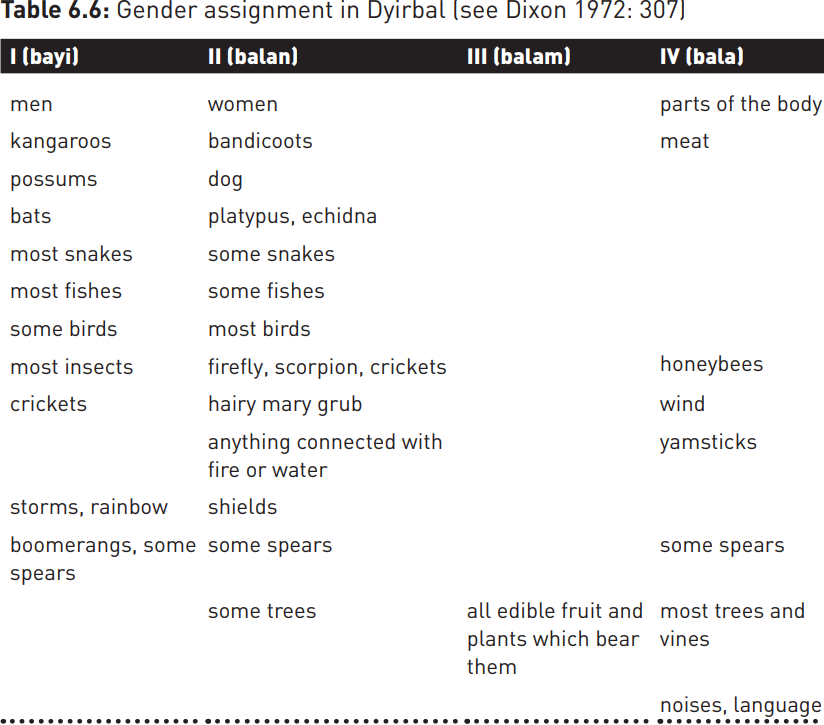
GENDER
 المؤلف:
David Hornsby
المؤلف:
David Hornsby
 المصدر:
Linguistics A complete introduction
المصدر:
Linguistics A complete introduction
 الجزء والصفحة:
126-6
الجزء والصفحة:
126-6
 2023-12-19
2023-12-19
 1442
1442
GENDER
The category of gender has long fascinated linguists and non-linguists alike, because it does not seem to serve any obvious linguistic purpose in the way that number or tense, for example, do. Moreover, it is something that non-native learners find particularly difficult to acquire. Its values, also called genders, are noun classes that affect the behavior of other items in the sentence: Spanish adjectives, for example, are inflected for the gender of the noun they qualify.
In traditional terminology, gender is often associated with a real-world distinction between male and female: for example the genders of French are labelled masculine and feminine. The terminology is often misleading, however, as in many languages the classification is not based even in part on distinctions of sex. Even in languages where it is, there are frequent anomalies: the German word for ‘girl’, Mädchen, for example is neuter, not feminine. Insofar as gender applies to inanimates, its assignment often seems arbitrary: the word for ‘sun’, for example, is masculine in Spanish (sol), feminine in German (Sonne) and neuter in Russian (solntse). For this reason, some linguists prefer the term noun classification to gender, which we have used here.
Gender in English affects only the pronoun system in the third person singular, and is based on animacy: male animates are he/him and females she/her. With one or two exceptions (large vehicles, ships and nations, for example, are often personified as she), all nouns referring to inanimates are assigned the pronoun it. Even the he/she distinction is not cross-linguistically universal: Finnish has a single subject pronoun hän, which means ‘he’ or ‘she’, as does Hungarian (where the pronoun ő has the same function).
In Italian, however, not only are humans gender-marked, but all inanimates are too, as in the following examples:

The Italian gender system is, for the most part, formally motivated in that, in the vast majority of cases, the word ending determines the gender: words ending in -a are feminine and those in -o are masculine. There are complications (nouns in -ma are generally masculine), and in some cases the semantic category of ‘sex’ can ‘trump’ the phonology, as in the case of atleta ‘athlete’, which is formally feminine by the above criterion but masculine when it refers to a male athlete.
As far as inanimates are concerned, however, semantics plays little part in gender assignment, and in other languages, the relationship between physical sex and grammatical gender is even more tenuous. Dutch, Danish and Swedish have all largely lost (but for some vestigial forms) the masculine/feminine distinction for inanimates and now have a two-way common (merged masculine and feminine)/neuter system instead.
Other gender systems are, however, semantically motivated. Tamil has three genders, broadly based on sex and animacy: the first class includes male humans and gods, the second female humans and goddesses, while the third includes inanimate objects. The Chichewa language of Malawi has ten genders, or noun-classes, assigned on a combination of semantic, morphological and phonological criteria.
An interesting semantics-based system is that of the Dyirbal language of northern Queensland, as originally described by Dixon (1972); see also Corbett (1991: 16–17).

Here, the semantic basis for gender assignment is that:
class I includes male humans and non-human animates
class II is females, water, fighting and fire
class III is food other than meat
class IV is a residue class for all other items.
Other principles, associated with the knowledge and belief systems of the Dyirbal speakers, account for apparent anomalies: many birds, for example, are included in class II because they are believed to be the spirits of dead human females; items believed to be harmful are included in class II, for example stinging trees or nettles, which one might expect to be assigned to class IV. This fascinating gender assignment system, which is opaque to those unfamiliar with the world view of Dyirbal speakers, is discussed in a 1987 book by George Lakoff, the main title of which is taken from what seems to be the semantic basis of the second noun class: Women, Fire and Dangerous Things.
 الاكثر قراءة في Syntax
الاكثر قراءة في Syntax
 اخر الاخبار
اخر الاخبار
اخبار العتبة العباسية المقدسة


